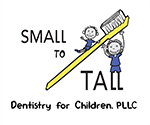Care of Your Child’s Teeth
Brush your child’s teeth daily as soon as the first tooth appears in the mouth. Use water or a “training toothpaste” until your child sees the dentist for their first visit. This should be at the first birthday or 6 months after the first tooth comes in. Small children should be encouraged to brush, but they do not have the skills to be able to brush and clean all their teeth properly. Until about age 7, parents need to be the ones getting the teeth clean. After that age, parents can supervise brushing and perform “spot checks” to make sure that the teeth are being brushed correctly.
Proper brushing removes plaque from the inner, outer and chewing surfaces. When teaching children to brush, place toothbrush at a 45 degree angle; start along gum line with a soft bristle brush in a gentle circular motion. Brush the outer surfaces of each tooth, upper and lower. Repeat the same method on the inside surfaces and chewing surfaces of all the teeth. Finish by brushing the tongue to help freshen breath and remove bacteria.
After age 7, children still need to be supervised by an adult to make sure that they are spending enough time, and reaching all the surfaces of the teeth. The best way to remember how long to brush and how often is: 2 minutes 2 times each day!
If you have any questions about your child’s brushing, be sure to ask when you bring your child in for their check up!
Flossing removes plaque between the teeth where a toothbrush can’t reach. Flossing is important because when food and plaque sit between the teeth, cavities can develop in between the teeth. These cavities can not be seen until your child is able to tolerate X-Rays (around age 4 or 5), or the cavity becomes so large that the tooth breaks! Therefore, flossing should begin as soon as two teeth touch each other. Use about 18 inches of floss, winding most of it around the middle fingers of both hands. Hold the floss lightly between the thumbs and forefingers. Use a gentle, back-and-forth motion to guide the floss between the teeth. Curve the floss into a C-shape and slide it into the space between the gum and tooth until you feel resistance. Gently scrape the floss against the side of the tooth. Repeat this procedure on each tooth. Don’t forget the backs of the last four teeth.
Some parents find that hand-held flossers are easier to use, and children can learn to use them independently to floss the front teeth by about age 7. You should continue to floss your child’s teeth until they can do it alone. Flossing is good for preventing cavities and gum disease. The sooner your child starts this habit the better!
If you have questions or would like help learning how to floss, be sure to bring it up at your child’s cleaning appointment!
